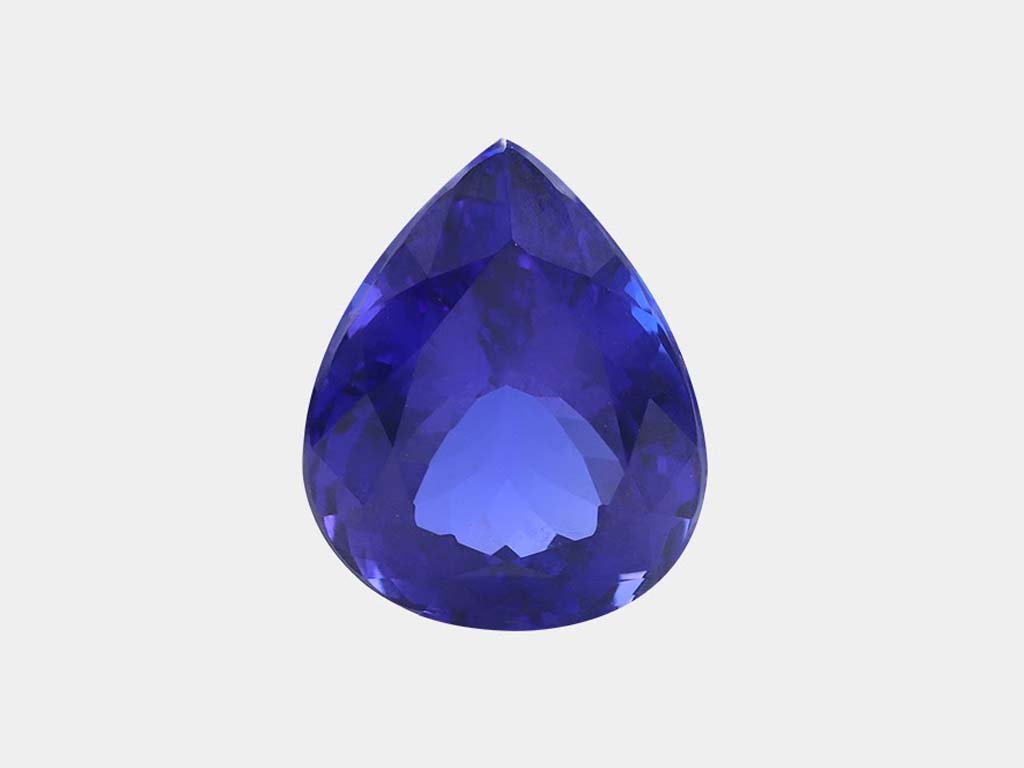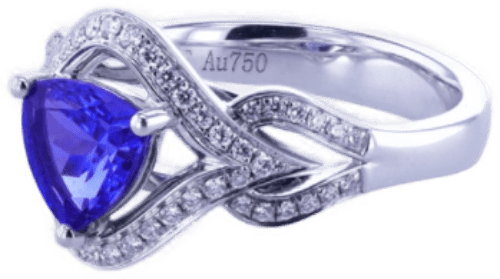Echa un vistazo a nuestro Nuevas Llegadas: ¡una variedad de selecciones ahora disponibles!
Tanzanite- the rarest of the gemstone- does not need any introduction. with Tanzanite Color jewelry has made its impression across the world, partly due to the many trendy designs available and largely due to the intriguing color of this mesmerizing gemstone. Tanzanite gemstone is a December birthstone that features a color like none other. Though it closely resembles blue sapphire, there is a distinction to its color like none other. In this blog, we will talk at length about the unique color of tanzanite and how it affects the price of this one-of-a-kind gemstone.
Tanzanite belongs to the mineral family zoisite. It was first discovered in 1967 and has a limited geographic origin. It was initially named blue zoisite but then was branded with the trade name tanzanite by Tiffany & Co. Tanzanite gemstone is exclusively found about eight square miles in the Merelani hills, near the base of Mount Kilimanjaro and the city of Arusha. Tanzanite color, along with its incredible metalogical and physical properties makes it a revered gemstone. The classic tanzanite stone color is blue but it represents a beautiful palate of violetish-blue.
Tanzanite color plays a crucial role in assessing its value. Its interesting color makes it 1000 times rarer than diamonds. If you are headed to buy tanzanite gemstone or tanzanite jewelry, you must know how the unique color of tanzanite plays a critical role in making this gemstone precious.

Zoisite mineral is naturally found in a wide palette of color ranges including red, blue, pink, brown, green, violet, and even colorless. Tanzanite, in particular, is a type of zoisite with a color range of blue to purple and violet to violetish purple.
It was the unique color of this gemstone that first intrigued gemmologists. Found in a naturally blue color, tanzanite color could be enhanced with several factors including heat and more, and hence a series of lab experiments were performed to decode what color is tanzanite. The result of these tests concluded that while tanzanite is naturally found in blue tones, certain naturally brown and green zoisites can also be converted into blue zoisite, making them a tanzanite gemstone. It was then that the tanzanite was marketed among gemstone enthusiasts and the rest is history.
When some amount of vanadium combines with the zoisite, it creates the mesmerizing blue color that tanzanite is best known for. Zoisites with vanadium, when heated at a certain temperature for about half an hour, the oxidation of vanadium takes place and the tanzanite color is enhanced.
Tanzanita are heated at a mild temperature of 600 degrees Celsius, unlike many other gemstones which demand a heat treatment of as high as 1000 and 1800 degrees Celsius.
Naturally tanzanite color is blue but a large chunk of tanzanite in the market is processed through heating to enhance its color. The heat of metamorphism is what causes the natural oxidation of vanadium and gives tanzanite its rare blue color. When buying tanzanite, buying untreated tanzanite is important to make a quality purchase.
Tanzanite color is a display of the blue family and primarily includes:
Blue: You can find tanzanite color in varied ranges of blue hues including deep blue, baby blue, and lighter tones. The broad palette of blue in tanzanite color is an enchanting quality of this gemstone.
Violet: From rich depths of purple to the elegant lavender violet, a tanzanite gemstone can be found in multiple shades of violet to soothe your eyes and fulfill your hunt for the best tanzanite stone.
Burgundy: While it is rare burgundy tanzanite color is also a possibility. When tanzanite gemstone is viewed from a certain angle, it can show beautiful burgundy overtones.

A range of factors including oxidation, as described above, affect tanzanite colors. Saturation, tone, and trichroism are other important factors affecting the tanzanite color and hence its value.
Tanzanite Color: Saturation
Color saturation is an important factor in deciding the value of tanzanite. It is the extent of how much the color fills the stone. Higher tanzanite color saturation makes it more valuable not only because it is the first thing that catches the eye but also because highly color-saturated tanzanite is rare.
A vivid and intense tanzanite stone color is what you should look for when buying the best tanzanite stone or a tanzanite jewelry piece. With the drop in saturation, the color drops, making the tanzanite less valuable and physically attractive.
The tanzanite color also affects its rarity as higher saturation tanzanite which shows a deep blue color only less than 1%. Initially, miners used to define the highest saturation of tanzanite stone color as aaa but with time, this grading system is no more effective.
Tanzanite Color: Tone
Tone does not describe the color saturation of tanzanite but how it overall appears and the extinction of light within it. Tone is affected by many reasons including poor cutting system. Many times, jewelry or gemstone sellers cut a tanzanite poorly to increase the weight which makes the stone look darker than it should. Although this dark stone would look more appealing to you, it is a distorted tone of the tanzanite color and hence must be avoided when buying.
The best way to check the tanzanite stone color tone is to look for the light reflection. The areas where the light reflects and does not extinct show its true color tone. Light extinction can cause the stone to look darker which is not the same as having higher saturation. The right balance of tone and saturation makes the best of Tanzanite’s.
Tanzanite Color: Trichroism
The trichroic property of tanzanite is what makes it the rarest of all gemstones. While tanzanite color in itself is an incredible property, trichorism makes it even more special. Trichorism is a gemological phenomenon that explains how light passes through a gemstone and reflects in different planes. Tanzanite is a high trichroic gemstone which gives it different colors. This means that tanzanite stone color chances depending on the axis you are looking it from. The type of light source also matters a lot as tanzanite reacts to light sources very incredibly. The trichorism phenomenon may not affect the value of a tanzanite but it is indeed a rare feature of the gemstone that defines tanzanite stone color.

There is so much to talk about tanzanite color and simultaneously a lot of doubts too. Customers often enquire about the tanzanite color being permanent. They also ask if it would fade away with time making the tanzanite look all dull and lifeless.
The good news is that time plays no role in depleting the glamor of a tanzanite stone color. The color remains the same and does not fade away. This means that your tanzanite stone jewelry will look all the way the same as it was when you first bought it.
However, it is important to remember that tanzanite stone reacts to heat so when exposed to extreme heat, it may change its color. So, it is important to keep it protected from extremely high temperatures and simultaneously take all the care precautions.
Now that you know all about tanzanite stone color and how it can vary from pure blue color to violetish and purplish hues, it is time to understand what tanzanite color is the most valuable. Tanzanite stone needs heat treatment to enhance its color but the 1% of naturally blue tanzanite stone is the most valued gemstone. The natural blue hue makes it a rare gemstone and looks striking when used in making blue tanzanite jewelry pieces or sold as a December gemstone.
Once you buy an actual tanzanite color, you can have the peace of mind that it is an incredible investment. Tanzanite stone has a great resale value when you buy it in the deep blue color. However, this does not mean that other hues of tanzanite are any less popular. Till the time you prevent heat exposure and take good care of your tanzanite gemstone to maintain its color, you can expect it to get sold at the best price.
There are several other factors other than tanzanite color that impact its price. These factors include cut, carat, and clarity.

Tanzanite color is a core determiner of its value and must be a critical consideration when investing in tanzanite. The deepest and purest hues of blue are the most valued ones. The saturation of the color is the key to evaluating the value of tanzanite along with its tone. Naturally blue tanzanite is the most precious one and heat-treated tanzanite color has different values, Overall, tanzanite is a beautiful stone, and tanzanite stone color is an important consideration to check if you are investing in a credible gemstone.
